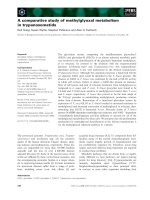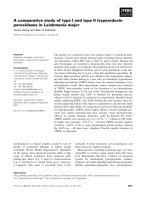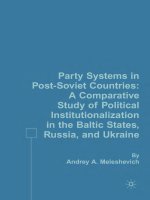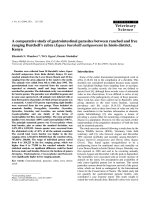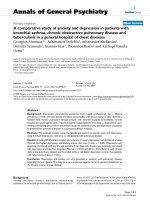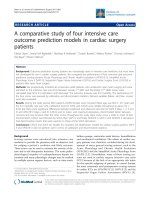party systems in post-soviet countries. a comparative study of political institutionalization in the baltic states, russia and ukraine. 2007
Bạn đang xem bản rút gọn của tài liệu. Xem và tải ngay bản đầy đủ của tài liệu tại đây (1.05 MB, 279 trang )
Party Systems in
Post-Soviet Countries
1403974497ts01.qxd 24-11-06 09:11 PM Page i
1403974497ts01.qxd 24-11-06 09:11 PM Page ii
This page intentionally left blank
PARTY SYSTEMS IN
POST-SOVIET COUNTRIES
A COMPARATIVE STUDY OF POLITICAL
INSTITUTIONALIZATION IN THE BALTIC
STATES, RUSSIA, AND UKRAINE
ANDREY A. MELESHEVICH
1403974497ts01.qxd 24-11-06 09:11 PM Page iii
PARTY SYSTEMS IN POST-SOVIET COUNTRIES
© Andrey A. Meleshevich, 2007.
All rights reserved. No part of this book may be used or reproduced in any
manner whatsoever without written permission except in the case of brief
quotations embodied in critical articles or reviews.
First published in 2007 by
PALGRAVE MACMILLAN™
175 Fifth Avenue, New York, N.Y. 10010 and
Houndmills, Basingstoke, Hampshire, England RG21 6XS
Companies and representatives throughout the world.
PALGRAVE MACMILLAN is the global academic imprint of the Palgrave
Macmillan division of St. Martin’s Press, LLC and of Palgrave Macmillan Ltd.
Macmillan® is a registered trademark in the United States, United Kingdom
and other countries. Palgrave is a registered trademark in the European
Union and other countries.
ISBN-13: 978–1–4039–7449–5
ISBN-10: 1–4039–7449–7
Library of Congress Cataloging-in-Publication Data
Meleshevich, Andrey A.
Party systems in post-Soviet countries: a comparative study of
political institutionalization in the Baltic States, Russia, and Ukraine /
Andrey A. Meleshevich.
p. cm.
Includes bibliographical references and index.
ISBN 1–4039–7449–7 (alk. paper)
1. Political parties—Baltic States—History. 2. Political parties—
Russia (Federation)—History. 3. Political parties—Ukraine—History.
4. Baltic States—Politics and government—1991– 5. Russia
(Federation)—Politics and government—1991– 6. Ukraine—Politics and
government—1991– I. Title.
JN6729.A979M45 2007
324.20947—dc22 2006049484
A catalogue record for this book is available from the British Library.
Design by Newgen Imaging Systems (P) Ltd., Chennai, India.
First edition: February 2007
10987654321
Printed in the United States of America.
1403974497ts01.qxd 24-11-06 09:11 PM Page iv
For Alla Meleshevich
1403974497ts01.qxd 24-11-06 09:11 PM Page v
1403974497ts01.qxd 24-11-06 09:11 PM Page ii
This page intentionally left blank
Contents
List of Tables ix
List of Figures xi
List of Abbreviations xiii
Acknowledgments xv
Introduction 1
Part I Measuring Political Institutionalization
in the Baltic States, Russia, and Ukraine
1. Conceptual Framework and Operational Indicators
of Political Institutionalization 9
2. Autonomy of the Party System: Recruitment into
the National Legislature 29
3. Autonomy of the Party System: Recruitment into
the Executive Branch 51
4. Autonomy of the Party System: Geographical
Patterns of Party Support 77
5. Stability of the Party System 97
6. Measuring Political Institutionalization: Conclusion 107
Part II Explaining Political Institutionalization
in the Baltic States, Russia, and Ukraine
7. The Role of the Old Communist Elites during the
Formative Stage of the Party System 115
1403974497ts01.qxd 24-11-06 09:11 PM Page vii
8. The Type of Government and the Party System 139
9. Political Consequences of the Post-Soviet Electoral Systems 165
10. “Parties of Power” and the Party System 193
Conclusion 205
Notes 215
Bibliography 229
Index 251
Contents
viii
1403974497ts01.qxd 24-11-06 09:11 PM Page viii
List of Tables
1.1 Criteria of Political Institutionalization Proposed by
Selected Scholars 12
1.2 Criteria and Operational Indicators of Political
Institutionalization 27
2.1 The Number and Percentage of Independent MPs Elected in
Lithuania, Russia, and Ukraine in Single-Member Districts,
1991–2003 34
2.2 Autonomy of the Party System: Recruitment into
the National Assembly in the Baltic States, Russia,
and Ukraine, 1991–2004 50
3.1 Brief Descriptions of Cabinets in Estonia, 1990–2004 55
3.2 Brief Descriptions of Cabinets in Latvia, 1990–2004 57
3.3 Brief Descriptions of Cabinets in Lithuania, 1990–2004 59
3.4 Brief Descriptions of Cabinets in the Russian
Federation, 1990–2004 62
3.5 Brief Descriptions of Cabinets in Ukraine, 1990–2004 68
3.6 Autonomy of the Party System: Recruitment into the
Cabinet in the Baltic States, Russia, and Ukraine,
1991–2004 73
4.1 Ukraine: Coefficient of Variability (CV ) of
Main Political Parties in Post-Independence Elections 81
4.2 Estonia: Coefficient of Variability (CV ) of Main
Political Parties in Postindependence Elections 82
4.3 Latvia: Coefficient of Variability (CV ) of Main Political
Parties in Postindependence Elections 82
4.4 Lithuania: Coefficient of Variability (CV ) of Main Political
Parties in Postindependence Elections 83
4.5 Russia: Coefficient of Variability (CV ) of Main Political
Parties in Postindependence Elections 84
4.6 Autonomy of the Party System: Regional Strength of Party
Identification in the Baltic States, Russia, and Ukraine,
1991–2004 94
1403974497ts01.qxd 24-11-06 09:11 PM Page ix
5.1 Two Indexes of Electoral Volatility in the Baltic States,
Russia, and Ukraine 100
5.2 Stability of the Party Systems in the Baltic States,
Russia, and Ukraine, 1991–2004 106
6.1 Levels of Political Institutionalization in the Five
Countries 108
7.1 Removal of the Provision on the Leading Party Role
(Article 6) from the Soviet Constitution and the
Constitutions of the Five Countries 127
9.1 Mean Seat and Vote Shares in the Legislature
after the First Postindependence Elections 175
9.2 Effective Number of Electoral (Nv) and Parliamentary
(Ns) Parties in the MMD in Postindependence
Elections in Lithuania, Russia, and Ukraine 182
9.3 Selected Statistics from Elections to the
Riigikogu, 1995–2003 189
List of Tables
x
1403974497ts01.qxd 24-11-06 09:11 PM Page x
List of Figures
4.1 Coefficient of Variability of Party Systems (CV) in Post-1991
Elections in the Baltic States, Russia, and Ukraine 87
5.1 Party System Stability: “Old” Parties’ Volatility Index 101
5.2 Party System Stability: Pedersen’s Index of Volatility 101
6.1 Political Institutionalization of Party Systems in the
Five Countries, 1991–2004 109
1403974497ts01.qxd 24-11-06 09:11 PM Page xi
1403974497ts01.qxd 24-11-06 09:11 PM Page ii
This page intentionally left blank
List of
Abbreviations
Estonia
CPE Communist Party of Estonia
EKe (ECP) Eesti Keskerakond (Estonian Center Party)
ERSP (ENIP) Eesti Rahvusliku So
~
ltumatuse Partei (Estonian National
Independence Party)
KMÜ Koonderakond ja Maarahva Ühendus (Estonian Coalition
Party and Rural Union)
ER (PFE) Eestimaa Rahvarinne (Popular Front of Estonia)
Latvia
CPLat Communist Party of Latvia
LKDS Latvijas Kristrgo Demokrgtu Savienrba (Latvian Christian
Democratic Union)
LNNK Latvijas Nacionglg Neatkarrbas Kustrba (Latvian National
Independence Movement)
LSP Latvijas Sociglistiskg Partija (Latvian Socialist Party)
LTF (LPF) Latvijas Tautas Fronte (Latvian Popular Front)
LZP Latvijas Zal
,
g Partija (Latvian Green Party)
LZS Latvijas Zemnieku Savienrba (Latvian Farmers Union)
TB Tevzemei un Brrvrbai (Fatherland and Freedom)
ZZS Zal
,
o un Zemnieku Savienrba (Union of Greens and
Farmers)
Lithuania
CPLit Communist Party of Lithuania
LCS Lietuvos Centro Sajunga (Lithuanian Center Union)
1403974497ts01.qxd 24-11-06 09:11 PM Page xiii
LDDP Lietuvos Demokratine Darbo Partija (Lithuanian
Democratic Labor Party)
LKDP Lietuvos Krikscioniu Democratu Partija (Lithuanian
Christian Democratic Party)
LSDP Lietuvos Socialdemokratu Partija (Lithuanian Social
Democratic Party)
TS/LK Tmvynms Sajunga/Lietuvos Konservatoriai (Homeland
Union/Lithuanian Conservatives)
Russian Federation
CPRF Communist Party of the Russian Federation
KRO Kongress Russkikh Obshchin (Congress of Russian
Communities)
LDPR Liberal’no-Demokraticheskaya Partiya Rossii (Liberal
Democratic Party of Russia)
NDR Nash Dom - Rossiya (Our Home Is Russia)
NPSR Narodno-Patrioticheskiy Soyuz Rosii (Popular Patriotic
Bloc of Russia)
ORV Otechestvo - Vsya Rossiya (Fatherland-All Russia)
PRES Partiya Rossiyskogo Edinstva i Soglasiya (Party of Russian
Unity and Accord)
SPS Soyuz Pravykh Sil (Union of Rightist Forces)
Ukraine
CPU Communist Party of Ukraine
NDP Narodno-Demokratychna Partiya (Popular Democratic
Party)
SPU Sotsialistychna Partiya Ukrainy (Socialist Party of Ukraine)
SDPU (U) Sotsial-Demokratychna Partiya Ukrainy (Ob”ednana)
(Social Democratic Party of Ukraine - United)
UNA Ukrains’ka Natsional’na Asambleya (Ukrainian National
Assembly)
UNSO Ukrains’ka Natsional’na Samooborona (Ukrainian Self-
Defense Force)
USSR
CPSU Communist Party of the Soviet Union
List of Abbreviations
xiv
1403974497ts01.qxd 24-11-06 09:11 PM Page xiv
Acknowledgments
I am greatly indebted to my numerous colleagues and friends without
whose assistance and encouragement this book would not have been possible.
I am in personal debt to Kristi Andersen, Ronald McDonald, Ralph Ketcham,
Paul Christensen, and Thomas Patterson who have guided my research in the
early stages of the project and have contributed to my professional growth
during my career at Syracuse University. I thank Lionel Simard for teaching a
non-native speaker many intricacies of the English language and editing the
first draft of the manuscript.
Parts of earlier drafts of this book have been discussed at numerous con-
ferences, seminars, or individual consultations. John Agnew, John Ishiyama,
Robert Kravchuk, Aleksandr Markarov, John Nagle, Mitchell Orenstein,
Thomas Remington, and an anonymous reviewer for Palgrave Macmillan
have all provided useful feedback and suggestions which have been incorpo-
rated in the final product. Naturally, I am alone responsible for all errors,
omissions, or inadequacies in methodology or interpretation.
My students deserve a special mention. I would like to record my gratitude
to Rob Shaw, Chris Lockman, Nick Rossmann, Dom Randazzo, Kerry Fraas,
Jim Saunders, Ben Long, Anna Bartosiewicz, Ryan O’Donnell, Gabe Fabian,
Dom Ionta, Halyna Kohan, Maria Semikoz and Bohdan Malnev for their
research support and assistance. Thank you for your hard work. It was a priv-
ilege to work with all of you.
I also want to express my sincere appreciation to Palgrave Macmillan Press
and their staff for their confidence in the project, patience, support, and good
advice along the way. I would like to thank Maran Elancheran for his
thorough copyediting of this manuscript.
Chapter 4 was first published as “Geographical Patterns of Party Support
in the Baltic States, Russia, and Ukraine,” in European Urban and Regional
Studies, vol. 13, no. 2, (2006), pp.113-129. It is copyright © 2006 by Sage
Publications, Thousand Oaks, London, and New Delhi, and reproduced by
permission. A selection from chapter 9 appeared as “The Double Ballot
Majority Electoral Model and Party System Formation: A Case Study of the
1993 Law on Elections of People’s Deputies of Ukraine,” in National
University of Kyiv-Mohyla Academy Review, Legal Studies Series, vol. 53
1403974497ts01.qxd 24-11-06 09:11 PM Page xv
(2006). An earlier version of chapter 10 appeared as “Parties of Power and
Party Systems in the Post-Soviet Nations,” Elections and Democracy (Vybory
ta Demokratiya), vol. 7, no. 1. I thank the publishers for permissions to
reproduce these materials.
I owe special thanks to my wife Alla for bearing with me for all these years
and for her intellectual and emotional support when I needed it most; to my
son, Kirill, for believing in all my professional endeavors; and last but not
least, to my parents, Irina Fedorova and Anatoliy Meleshevich.
Acknowledgments
xvi
1403974497ts01.qxd 24-11-06 09:11 PM Page xvi
Introduction
Few events in modern history can rival the political, economic, and
international transformations caused by the collapse of the Soviet empire in
1991, which concluded an unsuccessful and brutal social experiment that
started in 1917. These epochal changes brought significant confusion and tur-
moil into the academic field once known as Sovietology. Suddenly, researchers
faced not one relatively well-studied and stable country, but 15 increasingly
unpredictable, largely unknown entities. Robert Campbell, former director of
the Russian and Eastern European Studies Center at Indiana University,
described the state of the field in the early 1990s: “Our wealth was in a knowl-
edge of systems that don’t exist any more That was a society that despite
changes taking place was characterized by stasis. Once that ends, we have all
these problems with transitions. That’s something nobody knows how to study
very well” (Barringer, 1993, B8).
Following the initial confusion among academics about how to deal with
rapidly changing post-Soviet nations, most Western Sovietologists focused on
the Russian Federation, overlooking the other former Soviet republics. As a
result, the field of post-Soviet studies is dominated by Russia. In his article,
“The First Decade of Post-Communist Elections and Voting,” Joshua A.
Tucker (2002) analyzes academic publications on the topic of post-
Communist elections that appeared in 16 leading political science journals
between 1990 and 2000. His findings are striking. Russian elections are
exclusively examined in a major portion of research on post-Communist
elections. The Russian Federation is the sole subject of almost 85 percent of
all single-country studies of elections in the post-Soviet region. Tucker argues,
A similar pattern is present in book publication [I]t should raise some red
flags. If the field continues to develop in this direction, then there is a realistic
danger that much of what we learn about elections and voting in the post-
communist context will be based on our understanding of only one country,
and one that is hardly representative of the lot. (2002, 278, emphasis added)
Tucker’s analysis also demonstrates that post-Soviet studies are not only over-
shadowed by one country, but, in fact, lack a comparative perspective: “[T]he
1403974497ts02.qxd 18-11-06 06:06 PM Page 1
field of political science seems to have collectively shied away from the opportu-
nity to pursue comparative research” (ibid., 280). The author finds that of the
65 articles in his study devoted to the republics of the former Soviet Union, only
6, or 9 percent, compare two or more countries. All other investigations have a
single-country focus.
The few studies that do attempt to understand and investigate
cross-national comparisons among the former Soviet republics represent, as a
rule, multiauthored collections. These books have all the advantages and
disadvantages of a collaborative effort of multiple experts. On one hand, indi-
vidual authors are very knowledgeable regarding their particular topics of
interest. On the other hand, these studies lack a unified approach and com-
parisons across the case studies are hardly drawn. The multiauthored volume,
The Democratic Changes and Authoritarian Reactions in Russia, Ukraine,
Belarus and Moldova, edited by Karen Dawisha and Bruce Parrot (1997),
serves as an example. Scholars who contributed to the project were given
research guidelines for case studies. For example, they were asked to assess the
strength of the countries’ political parties and party systems. Although indi-
vidual authors had attempted to address this question, the book lacks a con-
sistent approach and cross-national comparisons. All scholars who
contributed to the study underlined the weakness and fragility of political
parties and party systems in the four countries. However, the investigation as
a whole fails to address whether there are any differences in levels of political
institutionalization of party systems in the countries that emerged after the
breakup of the former Soviet Union, and, if so, what factors have caused
relatively different degrees of party-system institutionalization in these
countries.
In sum, the academic field of post-Soviet studies in political science
currently suffers from several significant limitations: (1) it is dominated by
one country; (2) it lacks a comparative perspective; and (3) it lacks a unified
approach for consistent cross-national comparisons of the former Soviet
republics. Our knowledge of post-Communist transitional societies would be
greatly enhanced if social scientists pay more attention to all nations that
achieved their independence following the collapse of the Soviet Union.
***
Project Description and Outline
This book attempts to close some of the gaps left by previous post-Soviet
studies. It conducts a systematic multiple-country and multiple-election
examination of political institutions in the five former Soviet republics:
Estonia, Latvia, Lithuania, Russia, and Ukraine. The study starts with the
Party Systems in Post-Soviet Countries
2
1403974497ts02.qxd 18-11-06 06:06 PM Page 2
assumption that the strength or weakness of a party system serves as an important
determinant of whether democracy has a potential for survival: “[T]he historical
evidence suggests that the crucial consideration for democracy is the
degree of party institutionalization. All of our cases call attention to the insti-
tutional strength or weakness of parties as a determinant of success or failure
with democracy, and each of them grapples with the problem of institutional-
ization” (Diamond and Linz, 1989, 21). The two central questions of this
project are as follows: Are there differences in the levels and dynamics of insti-
tutionalization of party systems in the former republics of the Soviet Union?
What factors determine the different degrees of political institutionalization in
these countries?
The book has two parts. Part 1 consists of six chapters and measures party-
system institutionalization in the five post-Soviet countries. Chapter 1
presents a critical analysis of different approaches to political institutionaliza-
tion discussed in the literature. It also develops a detailed set of conceptual
criteria and operational indicators suitable for cross-country longitudinal
empirical analysis of levels and dynamics of party-system institutionalization.
In the analysis of the institutionalization of a party system, two broad criteria
are concerned: autonomy and stability. Autonomy requires that the institu-
tionalized organization should have an independent status and value of its
own vis-à-vis its external environment. Three indicators are employed for
measuring autonomy: (1) the role of political parties in the recruitment into
the legislative branch of government; (2) the role of political parties in the
formation of the executive branch; and (3) the strength of the party and the
uniformity of this strength in different regions across the country. The second
dimension, stability, suggests that the system should demonstrate regular
patterns of interaction between its elements, and this is measured by the
percentage of the vote share in a legislative election taken by the parties that
participated in any previous electoral contest and by Pedersen’s index of elec-
toral volatility. Chapter 1 serves as a theoretical framework for the next five
chapters that examine and assess the degree of party-system autonomy and
stability in the Baltic states, Russia, and Ukraine.
Chapter 2 investigates patterns of legislative recruitment in the five
nations. One of the principal, distinctive functions of a party system in a
democracy is to recruit politicians into legislative bodies. If a national parlia-
ment consists largely of members with previous careers within political par-
ties, then a party system is likely to have a high level of autonomy. Conversely,
if the system includes numerous parties whose representatives in the legisla-
ture have not had prior party careers, then its degree of autonomy is bound to
be low. In countries that employ a proportional representation system, it is
useful to assess electoral lists of political parties participating in elections. In
countries that use a majoritarian formula, a percentage of seats held by
3
Introduction
1403974497ts02.qxd 18-11-06 06:06 PM Page 3
independents in a national parliament is employed as an indicator of
autonomy. Chapter 3 extends the analysis by investigating patterns in the for-
mation of the cabinet. The second indicator of autonomy deals with another
important function of a party system: recruitment of politicians into the
executive branch of government. It assesses the relationship between the
party system and the Cabinet of Ministers. In an institutionalized party sys-
tem, a cabinet must be formed by a winning party or a coalition of parties.
The party system displays low autonomy if the top executive officers in a
country are not affiliated with political parties, especially those parties that
occupy a significant percentage of seats in the legislature.
Chapter 4 deals with the regional pattern of party strength and uses the
coefficient of variability to measure the electoral support for major national
parties across the entire territory of the country. A party system consisting of
organizations that are distinctly divided according to territorial lines, merely
expressing the interests of certain regions, and not having significant support
in others lacks autonomy and institutionalization across the nation. In an
institutionalized party system, as a rule, political parties should have a rela-
tively even electoral support in different parts of the country. Stability of a
party system as the second dimension of institutionalization is assessed in
chapter 5. It is measured by two statistical indexes (“old” parties’ volatility
index and Pedersen’s index of electoral volatility), which address different
aspects of electoral volatility of the party system. Chapter 6 concludes the
first part of the book project and summarizes the findings of the previous
four chapters. The main conclusion is that Estonia, Latvia, Lithuania, Russia,
and Ukraine reveal strikingly different patterns of institutionalization of their
party systems.
Part 2 attempts to explain different dynamics and levels of political insti-
tutionalization in the five nations. Chapter 7 explores the role of the old
Communist elites in the late 1980s and the early 1990s during the genetic
stage of party-system formation in the Baltic states, Russia, and Ukraine. By
combining the comparative historical sociological perspective with organiza-
tional theory, it examines how the behavior and policies of the individual or
the group decision makers were able to articulate institutional objectives,
establish an organization’s foundation, and define its framework in the
process of post-Communist institution building.
Chapter 8 makes a contribution to the current presidents versus parlia-
ments debate. It focuses on a somewhat narrow issue concerning the rela-
tionship between the type of government and the formation of the party
system in the post-Soviet countries. The chapter provides new evidence to
support the mainstream argument that the presidential form of government
is less conducive to the development of a meaningful multiparty system and
democratic consolidation in general. However, the book also shows that not
Party Systems in Post-Soviet Countries
4
1403974497ts02.qxd 18-11-06 06:06 PM Page 4
all accusations made in the literature against presidentialism in transitional
countries are supported by empirical evidence drawn from the five post-
Soviet states. Chapter 9 assesses the importance of different electoral arrange-
ments in the development of the post-Soviet party systems. It examines
which electoral rules and procedures are more favorable for the creation of
strong parties and the establishment of a meaningful competitive party
system. It also shows that similar electoral arrangements tend to produce
different political consequences in transitional post-Soviet countries as
compared to advanced Western democracies. Chapter 10 explores the post-
Communist phenomenon of parties of power and their effect on the overall
development of the party systems in the Baltic states, Russia, and Ukraine.
For the most part, these short-lived and nonideological political formations,
which comprise central and regional representatives of political and industrial
elites, harm institutionalization of political parties and contribute to high
levels of electoral volatility.
***
Country Selection
From the methodological point of view, Tucker’s finding about a lack of
cross-national comparative studies of the post-Soviet nations is surprising. The
countries emerging after the disintegration of the Soviet Union present
the researcher a unique and exciting opportunity—one of those rare examples
in political science when history creates “near-experimental” conditions. Neil J.
Smelter states, “The more similar two or more [cases] are with respect to cru-
cial variables the better able is the investigator to isolate and analyze the
influence of other variables that might account for the differences he wishes to
explain” (as cited in Lijphart, 1994, 78). Indeed, a comparative study of post-
Soviet nations allows the researcher to neutralize certain factors shared by all of
these countries in the recent past and still common to them. At the same time,
the “most-similar-system” design, undoubtedly relevant to post-Soviet
nations, allows the researcher to focus on the influence of those interactive
variables he/she wishes to study. For these reasons, one would expect a greater
number of comparative political investigations of the post-Soviet region.
Five countries—Estonia, Latvia, Lithuania, Russia, and Ukraine—have
been selected for this study based on three criteria: (1) the availability of elec-
toral data sufficient for the purposes of the longitudinal analysis; (2) reason-
ably free and fair parliamentary elections; and (3) the sovereignty of the
nation over its territory. For example, a lack of comparable voting statistics
with constituency breakdown for the 1994 and 1998 elections to the
Moldovan national legislature and breakaway Transnistria Region prevented
5
Introduction
1403974497ts02.qxd 18-11-06 06:06 PM Page 5
the inclusion of this country in my investigation. Belarus and most other
former Soviet republics were excluded from the study as these countries do
not correspond to the second criterion.
On the one hand, the Baltic states, Russia, and Ukraine used to be a part
of the same state, the Union of the Soviet Socialist Republics, which disinte-
grated in 1991. They had similar economic (highly centralized central-planned
economy and public ownership on the means of production), political (one-
party rule, lack of a competitive party system, meaningful election, and civil
society), and social conditions (active role of the state in the redistribution of
income and a relatively high level of social protection of the population). The
five nations represent the same geographical region, the European part of
the former Soviet Union. All of them declared as their goal the establishment
and consolidation of a free market economy and democratic political regime.
On the other hand, during the process of democratic transition these
nations have developed distinct institutional frameworks, including different
types of electoral formulas and governmental systems. For example, Estonia
and Latvia combine the proportional representation model and a parliamen-
tary republic. Both Lithuania and Russia adopted a mixed PR/majority elec-
toral formula. Ukraine used the majority run-off elections in single-member
districts for its founding elections and then switched to the mixed formula.
The institution of the presidency is an extremely powerful, predominant
force in the Russian political system. Until 2006, a strong president shared
power with two other bodies of government: the parliament and the cabinet
in Ukraine. The Lithuanian system, which combines a directly elected presi-
dent and a prime minister who depends on parliamentary support, is leaning
toward parliamentarism in practice. During the formative stage of their
national party systems, political elites in the five nations conducted distinctly
different policies toward emerging non-Communist political organizations.
The Baltic states, Russia, and Ukraine also developed different models with
different roles for nomenklatura (i.e., a list of senior positions in the
Communist countries and appointees to these offices that required a prior
approval by the Communist Party) and parties of power in their political
systems. These four variables (the role of political elites, type of government,
electoral system, and the place of parties of power) serve as explanatory factors
of different levels of political institutionalization in the five nations.
Although the empirical material in the present study covers a 15-year
period from the late 1980s to mid-2004, the author has also attempted to
incorporate the most recent academic literature available after the data collection
stage of the research was concluded.
Party Systems in Post-Soviet Countries
6
1403974497ts02.qxd 18-11-06 06:06 PM Page 6
Part I
Measuring Political
Institutionalization
in the Baltic States,
Russia, and Ukraine
1403974497ts03.qxd 24-11-06 09:12 PM Page 7
1403974497ts01.qxd 24-11-06 09:11 PM Page ii
This page intentionally left blank

